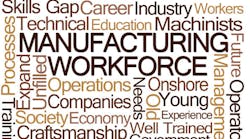Closing the Manufacturing Workforce Skills Gap
A thriving workforce has long been the fuel supply for our industry’s engine of growth. But today that fuel supply is in jeopardy as manufacturers and industrial operators around the world contend with the issue of workforce availability – a result of evolving job requirements and aging workers with deep process understanding leaving the workforce.
More than a challenge to manufacturing success, McKinsey Global Institute warns that workforce availability threatens to reduce economic growth by 40%, despite continuing productivity from automation and other elements of supply-chain optimization.
The problem is global. Deloitte estimates nearly 3.5 million manufacturing jobs will likely need to be filled in the U.S. from 2015 to 2025, and the skills gap will leave 2 million of them unfilled. Meanwhile, the U.N. reports that China’s over-65 population will surge from 8% to 23% between 2010 and 2040 – even as Chinese factories today struggle to fill positions. In Europe, citizens will need to work to a later age to support the Europe 2020 Strategy of increasing general employment to 75%.
Further complicating matters is the emergence of the Internet of Things and the convergence of information technology (IT) and operations technology (OT), which are creating additional skills gaps, and forcing manufacturers and industrial operators to reshape their workforces. Workers need new skills that are not easily found in today’s workforce to enable this convergence and to take advantage of new technology.
There is no single or short-term fix for overcoming these profound demographic changes and technology skills gaps. But there are some key areas where manufacturers and industrial operators can better prepare their operations and empower their workers to adjust to the challenge ahead.
Attracting Tomorrow’s Workforce
Manufacturers and industrial operators face a formidable challenge – attracting tomorrow’s workers while preserving the collective knowledge and experience of the baby boomer workforce. They must nurture a new generation of tech-savvy production workers and managers who are ready to face the challenge ahead. This requires attracting students early, feeding their interest in manufacturing, and showing the benefits of a career in manufacturing.
STEM (science, technology, engineering and math) education is a critical aspect of innovation and global competitiveness. According to the U.S. Bureau of Labor Statistics, the rate of STEM field job growth will outpace overall job growth by nearly double by 2018. To meet the demand, companies can start by acquainting parents and educators with an accurate picture of modern manufacturing jobs.
To be successful, manufacturers and industrial operators must view training as a competitive differentiator rather than an expense.
—Blake Moret
Events such as “Manufacturing Day” give students, parents and teachers a firsthand view of the wide array of interesting and rewarding manufacturing jobs. In addition, programs such as the FIRST Robotics Competition and Project Lead the Way complement STEM academic programs to reinforce problem-solving skills and provide hands-on experience.
Developing the Workforce
Manufacturers and industrial operators traditionally value employees with long-term, practical experience. These employees can identify potential problems using their familiarity with certain machines. However, as machinery becomes more connected in the plant and across facilities, companies increasingly need workers who are familiar with diverse control and information technologies. To keep experienced workers at the top of their game, companies need to get serious about lifelong learning.
The best trained workers have continuous learning opportunities throughout their adult lives. Advancing technologies and evolving company processes require a highly-trained, agile workforce. As the Industrial Internet of Things expands and IT and OT systems converge, companies need to equip workers with new skills to enable this convergence and take advantage of newly available information that can drive better decisions.
To be successful, manufacturers and industrial operators must view training as a competitive differentiator rather than an expense. They must incorporate the need for lifelong learning into their business plans, right down to utilization targets for direct labor and provision for initial on-the-job education for new hires. In addition, private and federally funded job training programs must target industry-needed skills and competencies.
Equipping the workforce for smart factories of the future is difficult, and most companies express concern about their current workforce’s ability to meet the demands. To keep up, workers need to be problem-solvers, creative thinkers and self-directed learners. Traditional one-size-fits-all classroom instruction won’t be enough, especially for younger students and employees. The most effective education will include competency-based, multimedia instruction using cooperative work/learning assignments and courseware with simulations of real-life manufacturing situations.
To make this happen, companies and educational institutions must establish more sustainable partnerships to align current and future human resource needs with diverse educators, including community colleges, universities and industry-sponsored continuing educational programs.
In the meantime, if a manufacturer or industrial operator has limited resources or can’t find the talent, technology suppliers can augment existing workforces by providing design assistance and modeling, commissioning help and remote technical support.
Embracing the Change
Manufacturing has evolved far beyond the days of workers tied to dedicated, repetitive jobs. In fact, industrial operations will more radically change in the next five years than they have in the last 20.
As manufacturers and industrial operators converge their IT and OT systems and build a connected enterprise to be more productive, job requirements will continue to evolve to maximize the benefits. In a connected enterprise, workers have real-time access to production information that can be communicated via alarms to the right people at the right time. They can more easily engage with aggregate data from multiple sources and across plants. They also can share scarce subject-matter expertise with workers located around the world via remote monitoring and other data-driven services.
Find a Collection of the Latest Information About the Connected Enterprise
The benefits of this increased information-sharing are profound – companies are more competitive due to faster time-to-market, lower total cost of ownership, increased asset utilization and improved risk mitigation.
Companies that adopt progressive employee development practices while embracing the connected enterprise will be more competitive in the future. They’ll gain a long-term competitive advantage through a more engaged workforce that has the tools and training to succeed in smart factories of the future.
Blake Moret is senior vice president, Control Products & Solutions, Rockwell Automation. He has more than 25 years of experience in sales, systems, service and product groups across Rockwell Automation. He is the chairman of the board of trustees for The Manufacturing Institute, an affiliate of the National Association of Manufacturers.





